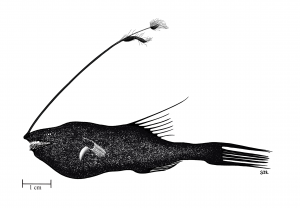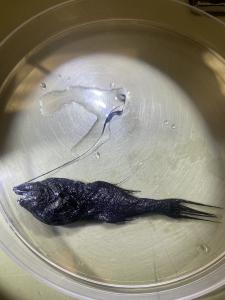UH-discovered deep-sea anglerfish named to top 10 remarkable species list
University of Hawaiʻi at MānoaOutreach Specialist, School of Ocean and Earth Science and Technology
A new species of anglerfish, Gigantactis paresca, discovered by University of Hawaiʻi at Mānoa oceanographers, was recently announced among the top 10 remarkable new marine species of 2024 by the World Register of Marine Species (WoRMS). This top-ten list highlights some of the estimated 2,000 fascinating new marine species discovered every year.
The anglerfish was initially collected during a UH Mānoa Department of Oceanography-led research cruise in 2021 to the Clarion-Clipperton Zone, a vast area of abyssal ocean southeast of Hawaiʻi. The scientific team aboard the cruise aimed to establish a baseline of the ecosystem and assess potential impacts of proposed deep sea mining.
“I hope this discovery emphasizes how much more there is to discover about the ocean and highlights the importance of protecting this region in which many species are still unknown to humans,” said Samantha Rickle, who published the discovery of the new species in 2024, and is a graduate student in Jeff Drazen’s Deep-Sea Fish Ecology Laboratory.
Anglerfish are named for their unique approach to predation, in which they use a bioluminescent bait at the tip of their lure that extends over their head. The newly discovered anglerfish is distinct from its relatives in that it contains a non-light-bearing secondary bait, in addition to the primary bait. Rickle shared that this unique lure morphology has never been recorded in any other type of angler, giving rise to the species name paresca, meaning pair of bait in Latin.
Making the discovery
In 2022, Rickle started working as an undergraduate researcher in the Drazen lab where her job was to identify the fish brought back from the 2021 research cruises.
“The first time I examined this fish, it was very clearly something not previously seen in taxonomic literature,” said Rickle. “I remember getting Jeff from his office and looking at it under the microscope and we agreed the lure, in particular, was incredibly unique from any other Gigantactinid. We were both extremely excited to be looking at something completely new to science.”
After the initial identification, there were a couple rounds of validating this as a new species, including sending the fish to Ted Pietsch, an anglerfish expert, at the University of Washington, who confirmed it was new to him, as well.
Continuing investigations of deep sea ecosystems
Because of her work with this new species, Rickle became interested in taxonomy and started working in the Ichthyology collection at Bishop Museum, where she worked to formally name and describe the fish and assisted with designing posters and exhibits. Rickle completed her bachelor’s in marine biology, continues to work as a technician at Bishop Museum, and is now pursuing her master's degree in biological oceanography in the UH Mānoa School of Ocean and Earth Science and Technology.
For her master’s thesis research, Rickle will continue to work on the same specimens identified during her undergraduate research position, and gain a clearer understanding of connectivities within the water column prior to the commencement of deep-sea mining.
“With all the specimens and data collected during the two cruises from the Clarion-Clipperton Zone in 2021, there is so much more research we can be conducting,” said Rickle. “I look forward to continue working on this dataset which I'm already familiar with and learning even more about this important and mysterious ecosystem.”


